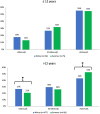Low socioeconomic status predicts vitamin D status in a cross-section of Irish children
- PMID: 35912305
- PMCID: PMC9334117
- DOI: 10.1017/jns.2022.57
Low socioeconomic status predicts vitamin D status in a cross-section of Irish children
Abstract
Vitamin D is essential for bone and muscle health with adequate status in childhood crucial for normal skeletal development. We aimed to investigate vitamin D status in a convenience sample (n = 1226) of Irish children (aged 1-17 years) who had serum 25-hydroxyvitamin D (25(OH)D) tested by request of their GP at a Dublin Hospital between 2014 and 2020. We examined predictors including age, sex, season and socioeconomic status (SES). Vitamin D deficiency (<30 nmol/l) was prevalent affecting 23 % and was more common in disadvantaged areas (34 %) and in those aged >12 v. ≤12 years (24 % v. 16 %, P = 0⋅033). The greatest predictor was SES (disadvantaged v. affluent, OR 2⋅18, CI 1⋅34, 3⋅53, P = 0⋅002), followed by female sex (OR 1⋅57, CI 1⋅15, 2⋅14, P = 0⋅005) and winter season (October to February, OR 1⋅40, CI 1⋅07, 1⋅84, P = 0⋅015). A quarter of our sample of children were deficient, rising to one-third in those in disadvantaged areas. Females and those aged over 12 years had a higher prevalence of deficiency. Public health strategies to improve vitamin D status in Irish children, including systematic food fortification may need to be considered to address this issue.
Keywords: 25(OH)D; Childhood; Ireland; Socioeconomic status; Vitamin D; Vitamin D deficiency.
© The Author(s) 2022.
Figures



References
-
- Scientific Advisory Committee on Nutrition (2016) SACN Vitamin D and Health Report. Available at https://www.gov.uk/government/groups/scientific-advisory-committee-on-nu... (accessed 25 March 2020).
-
- Food Safety Authority of Ireland (FSAI) (2020) Scientific Recommendations for Food-Based Dietary Guidelines for 1 to 5 Year-Olds in Ireland (accessed 7 June 2022).
-
- Goldacre M, Hall N & Yeates DG (2014) Hospitalisation for children with rickets in England: a historical perspective. Lancet 383, 597–598. - PubMed
-
- Julies P, Lynn RM, Pall K, et al. (2020) Nutritional rickets under 16 years: UK surveillance results. Arch Dis Child 105, 587–592. - PubMed
Publication types
MeSH terms
Substances
LinkOut - more resources
Full Text Sources
Medical

